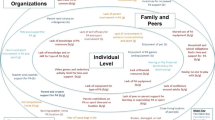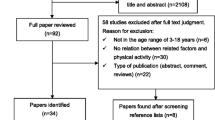Abstract
Low physical activity is a major health issue among Chinese Americans. This study explored Chinese–American children’s physical activity behaviors and influencing factors. Twenty-five children of Chinese or Taiwanese descent were interviewed to understand their favorite sports or physical activities, physical activity environments, and influences on their physical activity. All were between the ages of 9 and 13. Interviews were transcribed and coded using thematic data analysis procedures. Major themes included: (1) team sports, particularly basketball, were commonly listed as favorite sports or activities; (2) physical activity occurred mostly at school or an after-school setting; and (3) family played a major role in physical activity. Some trends/differences were detected based on age, sex, and socioeconomic status. Interventions to promote physical activity among Chinese–American children should emphasize team sports and encourage physical activity in schools, but also explore ways to involves families outside of school.

Similar content being viewed by others
References
U.S. Census Bureau. Selected population profile in the United States: 2005 American Community Survey. http://factfinder.census.gov/. Accessed 22 Dec 2015.
U.S. Census Bureau. Selected population profile in the United States: 2014 American Community Survey 1-year estimates. http://factfinder.census.gov/. Accessed 2 Nov 2015.
Centers for Disease Control and Prevention. CDC health disparities and inequalities report—United States, 2013. MMWR Morb Mortal Wkly Rep. 2013;62(Suppl 3):1–187.
Rodriguez BL, Fujimoto WY, Mayer-Davis EJ, Imperatore G, Williams DE, Bell RA, et al. Prevalence of cardiovascular disease risk factors in U.S. children and adolescents with diabetes: The SEARCH for Diabetes in Youth Study. Diabetes Care. 2006;29:1891–6.
Bates LM, Acevedo-Garcia D, Alegria M, Krieger N. Immigration and generational trends in body mass index and obesity in the United States: results of the National Latino and Asian American Survey, 2002–2003. Am J Publ Health. 2008;98:70–7.
Durstine JL, Gordon B, Wang Z, Luo X. Chronic disease and the link to physical activity. J Sport Health Sci. 2013;2:3–11.
Kruk J. Physical activity in the prevention of the most frequent chronic diseases: an analysis of the recent evidence. Asian Pac J Cancer Prev. 2007;8:325–38.
Thompson PD, Buchner D, Piña IL, Balady GJ, Williams MA, Marcus BH, et al. Exercise and physical activity in the prevention and treatment of atherosclerotic cardiovascular disease: a statement from the Council on Clinical Cardiology (Subcommittee on Exercise, Rehabilitation, and Prevention) and the Council on Nutrition, Physical Activity, and Metabolism (Subcommittee on Physical Activity). Circulation. 2003;107:3109–16.
Warburton DER, Nicol CW, Bredin SSD. Health benefits of physical activity: the evidence. CMAJ. 2006;174:801–9.
Maxwell AE, Crespi CM, Alano RE, Sudan M, Bastani R. Health risk behaviors among five Asian American subgroups in California: identifying intervention priorities. J Immigr Minor Health. 2012;14:890–4.
Taylor VM, Yasui Y, Tu SP, Neuhouser ML, Li L, Woodall E, et al. Heart disease prevention among Chinese immigrants. J Community Health. 2007;32:299–310.
Lee MM, Wu-Williams A, Whittemore AS, Zheng S, Gallagher R, Teh CZ, et al. Comparison of dietary habits, physical activity and body size among Chinese in North America and China. Int J Epidemiol. 1994;23:984–90.
Berry JW. Immigration, acculturation, and adaptation. Appl Psychol. 1997;46:5–34.
Gerber M, Barker D, Pühse U. Acculturation and physical activity among immigrants: a systematic review. J Publ Health. 2012;20:313–41.
Belza B, Walwick J, Schwartz S, LoGerfo J, Shiu-Thornton S, Taylor M. Older adult perspectives on physical activity and exercise: voices from multiple cultures. Prev Chronic Dis. 2004;1:A09.
Suen YN, Cerin E, Wua SL. Parental practices encouraging and discouraging physical activity in Hong Kong Chinese preschoolers. J Phys Act Health. 2015;12:361–9.
Brodersen NH, Steptoe A, Boniface DR, Wardle J. Trends in physical activity and sedentary behaviour in adolescence: ethnic and socioeconomic differences. Br J Sports Med. 2007;41:140–4.
Bauman AE, Reis RS, Sallis JF, Wells JC, Loos RJF, Martin BW. Correlates of physical activity: why are some people physically active and others not? Lancet. 2012;380:258–71.
Sallis JF, Prochaska JJ, Taylor WC. A review of correlates of physical activity of children and adolescents. Med Sci Sports Exerc. 2000;32:963–75.
Kim S, Symons M, Popkin BM. Contrasting socioeconomic profiles related to healthier lifestyles in China and the United States. Am J Epidemiol. 2004;159:184–91.
Musselman EA. Factors influencing engagement in physical activity among female Chinese American college students [dissertation]. Newark: Rutgers University; 2014.
Araki K, Kodani I, Gupta N, Gill DL. Experiences in sport, physical activity, and physical education among Christian, Buddhist, and Hindu Asian adolescent girls. J J Prev Med Publ Health. 2013;46:S43–9.
Telama R, Yang X, Viikari J, Välimäki I, Wanne O, Raitakari O. Physical activity from childhood to adulthood: a 21-year tracking study. Am J Prev Med. 2005;28:267–73.
Telama R, Yang X, Leskinen E, Kankaanpää A, Hirvensalo M, Tammelin T, et al. Tracking of physical activity from early childhood through youth into adulthood. Med Sci Sports Exerc. 2014;46:955–62.
Janz KF, Dawson JD, Mahoney LT. Tracking physical fitness and physical activity from childhood to adolescence: the Muscatine study. Med Sci Sports Exerc. 2000;32:1250–7.
Satia-Abouta J, Patterson RE, Neuhouser ML, Elder J. Dietary acculturation: applications to nutrition research and dietetics. J Acad Nutr Diet. 2002;102:1105–18.
Satia-Abouta J. Dietary acculturation: definition, process, assessment, and implications. Int J Hum Ecol. 2003;4:71–86.
Morgan DL. Planning focus groups: Focus group kit #2. Thousand Oaks: Sage Publications, Inc.; 1998.
Suinn RM, Ahuna C, Khoo G. The Suinn-Lew Asian self-identity acculturation scale: concurrent and factorial validation. Educ Psychol Meas. 1992;52:1041–6.
Braun V, Clarke V. Using thematic analysis in psychology. Qual Res Psychol. 2006;3:77–101.
Taverno SE, Rollins BY, Francis LA. Generation, language, body mass index, and activity patterns in Hispanic children. Am J Prev Med. 2010;38:145–53.
Sallis JF, Slymen DJ, Conway TL, Frank LD, Saelens BE, Cain K, et al. Income disparities in perceived neighborhood built and social environment attributes. Health Place. 2011;17:1274–83.
Wilson DK, Kirtland KA, Ainsworth BE, Addy CL. Socioeconomic status and perceptions of access and safety for physical activity. Ann Behav Med. 2004;28:20–8.
Fitzgerald N. Acculturation, economic status, and health among Hispanics. NAPA Bull. 2010;34:28–46.
Negy C, Woods DJ. A note on the relationship between acculturation and socioeconomic status. Hisp J Behav Sci. 1992;14:248–51.
Li J, Hummer RA. The relationship between duration of US residence, educational attainment, and adult health among Asian immigrants. Popul Res Policy Rev. 2014;34:49–76.
Jang H, Koo FK, Ke L, Clemson L, Cant R, Fraser DR, et al. Culture and sun exposure in immigrant East Asian women living in Australia. Women Health. 2013;53:504–18.
Milteer RM, Ginsburg KR, Mulligan DA, Ameenuddin N, Brown A, Christakis DA, et al. The importance of play in promoting healthy child development and maintaining strong parent-child bond: focus on children in poverty. Pediatrics. 2012;129:e204–13.
Palreddy S. Sports participation among South Asian Americans: the influence of acculturation and value of sport [dissertation]. Milwaukee: The University of Wisconsin-Milwaukee; 2012.
Hsin A, Xie Y. Explaining Asian Americans’ academic advantage over whites. Proc Natl Acad Sci USA. 2014;111:8416–21.
Peng SS, Wright D. Explanation of academic achievement of Asian American students. J Educ Res. 1994;87:346–52.
Kelder SH, Springer AS, Barroso CS, Smith CL, Sanchez E, Ranjit N, et al. Implementation of Texas Senate Bill 19 to increase physical activity in elementary schools. J Publ Health Policy. 2009;30:S221–47.
Barroso CS, Kelder SH, Springer AE, Smith CL, Ranjit N, Ledingham C, et al. Senate Bill 42: implementation and impact on physical activity in middle schools. J Adolesc Health. 2009;45:S82–90.
Fernandes M, Sturm R. Facility provision in elementary schools: correlates with physical education, recess, and obesity. Prev Med. 2010;50:S30–5.
Johnston LD, Delva J, O’Malley PM. Sports participation and physical education in American secondary schools: current levels and racial/ethnic and socioeconomic disparities. Am J Prev Med. 2007;33:S195–208.
Sleddens EFC, Kremers SPJ, Hughes SO, Cross MB, Thijs C, De Vries NK, et al. Physical activity parenting: a systematic review of questionnaires and their associations with child activity levels. Obes Rev. 2012;13:1015–33.
Barr-Anderson DJ, Adams-Wynn AW, Disantis KI, Kumanyika S. Family-focused physical activity, diet and obesity interventions in African-American girls: a systematic review. Obes Rev. 2013;14:29–51.
Wilson DK. New perspectives on health disparities and obesity interventions in youth. J Pediatr Psychol. 2009;34:231–44.
Brown T, Smith S, Bhopal R, Kasim A, Summerbell C. Diet and physical activity interventions to prevent or treat obesity in south asian children and adults: a systematic review and meta-analysis. Int J Environ Res Publ Health. 2015;12:566–94.
Maturo CC, Cunningham SA. Influence of friends on children’s physical activity: a review. Am J Publ Health. 2013;103:e23–38.
Salvy SJ, de la Haye K, Bowker JC, Hermans RCJ. Influence of peers and friends on children’s and adolescents’ eating and activity behaviors. Physiol Behav. 2012;106:369–78.
Sawka KJ, McCormack GR, Nettel-Aguirre A, Hawe P, Doyle-Baker PK. Friendship networks and physical activity and sedentary behavior among youth: a systematized review. Int J Behav Nutr Phys Act. 2013;10:130.
Sherar LB, Esliger DW, Baxter-Jones ADG, Tremblay MS. Age and gender differences in youth physical activity: does physical maturity matter? Med Sci Sports Exerc. 2007;39:830–5.
Whitt-Glover MC, Taylor WC, Floyd MF, Yore MM, Yancey AK, Matthews CE. Disparities in physical activity and sedentary behaviors among US children and adolescents: prevalence, correlates, and intervention implications. J Publ Health Policy. 2009;30:S309–34.
Heath GW, Parra DC, Sarmiento OL, Andersen LB, Owen N, Goenka S, et al. Evidence-based intervention in physical activity: lessons from around the world. Lancet. 2012;380:272–81.
Kriemler S, Meyer U, Martin E, van Sluijs EMF, Andersen LB, Martin BW. Effect of school-based interventions on physical activity and fitness in children and adolescents: a review of reviews and systematic update. Br J Sports Med. 2011;45:923–30.
van Sluijs EMF, McMinn AM, Griffin SJ. Effectiveness of interventions to promote physical activity in children and adolescents: systematic review of controlled trials. BMJ. 2007;335:703.
Chen J-L, Weiss S, Heyman MB, Lustig RH. Efficacy of a child-centred and family-based program in promoting healthy weight and healthy behaviors in Chinese American children: a randomized controlled study. J Publ Health (Oxf). 2010;32:219–29.
Chen J-L, Weiss S, Heyman MB, Vittinghoff E, Lustig R. Pilot study of an individually tailored educational program by mail to promote healthy weight in Chinese American children. J Spec Pediatr Nurs. 2008;13:212–22.
Acknowledgments
The authors would like to thank all the participating children and their parents, as well as the staff members at the community/cultural centers. Thank you also to Tzu-An Chen for her recruitment efforts and Alicia Beltran for the NVivo training. This research was funded by institutional support from the US Department of Agriculture/Agricultural Research Service under Cooperative Agreement no. 58-6250-0-008. At the time of study, CSD was supported by a Primary Care Research Training Grant from National Research Service Award (#T32 HP10031).
Author information
Authors and Affiliations
Corresponding author
Rights and permissions
About this article
Cite this article
Diep, C.S., Leung, R., Thompson, D. et al. Physical Activity Behaviors and Influences Among Chinese–American Children Aged 9–13 Years: A Qualitative Study. J Immigrant Minority Health 19, 358–366 (2017). https://doi.org/10.1007/s10903-016-0457-4
Published:
Issue Date:
DOI: https://doi.org/10.1007/s10903-016-0457-4




